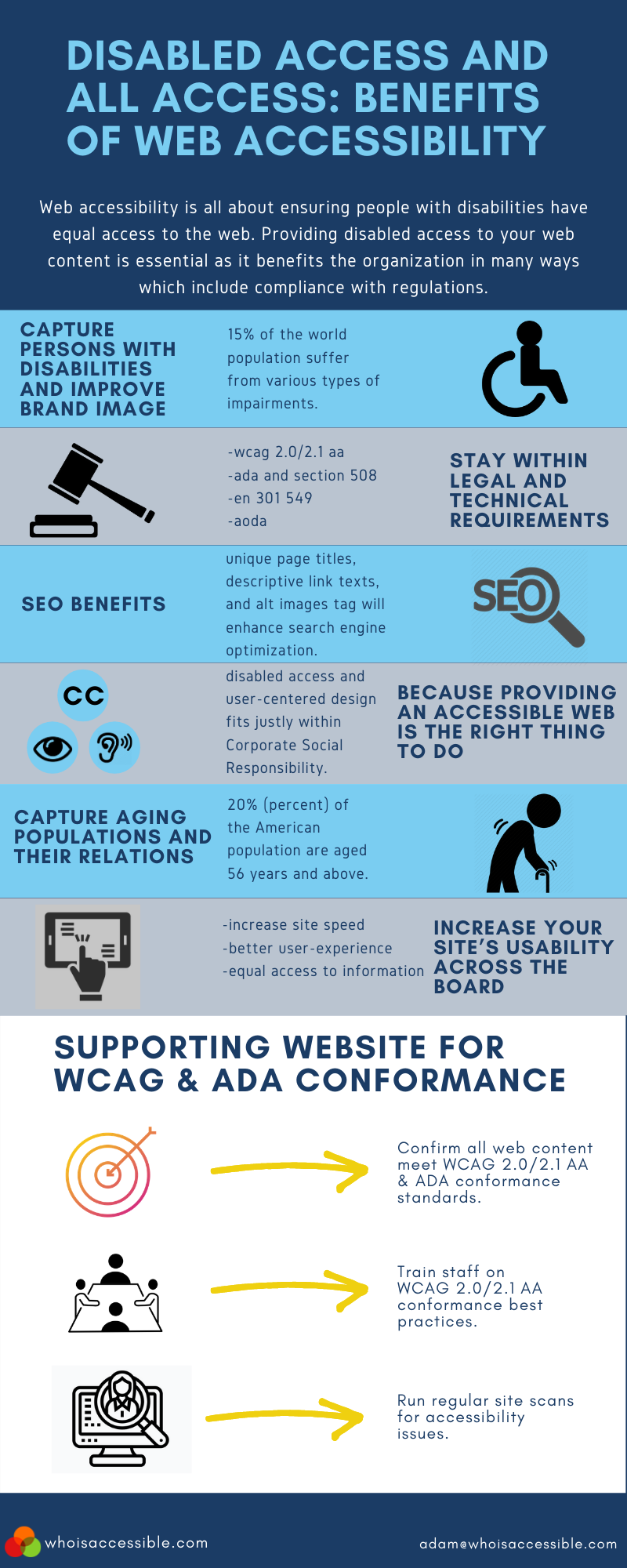Web accessibility is important. It allows everyone to use the internet. ADA and WCAG are guidelines for this. They help make websites accessible to all. This includes people with disabilities.
But there is more. ADA/WCAG compliance also helps with SEO. Search engines like Google reward accessible websites. This means more visitors to your site. Let's learn more about this.

Credit: www.mgt-commerce.com
What is ADA/WCAG Compliance?
ADA stands for Americans with Disabilities Act. WCAG stands for Web Content Accessibility Guidelines. Both aim to make the web usable for everyone. They provide rules for web design and content.
These rules include things like:
- Using text that is easy to read
- Providing captions for videos
- Making sure websites can be used with a keyboard
- Giving images descriptive text
Following these rules helps people with disabilities. It also helps everyone else. Clear, simple websites are easier for all users.

Credit: www.whoisaccessible.com
Benefits of ADA/WCAG Compliance for SEO
Now, let's talk about SEO. SEO stands for Search Engine Optimization. It is how you get your site to rank high on search engines. ADA/WCAG compliance helps with this. Here are some benefits:
1. Improved User Experience
Accessible websites are easier to use. This means users stay longer. They visit more pages. Search engines notice this. They reward sites that keep users happy.
2. Better Mobile Usability
Many people use phones to browse the web. Accessible sites work well on all devices. This includes phones and tablets. Search engines like this. They rank mobile-friendly sites higher.
3. Lower Bounce Rates
Bounce rate is when users leave quickly. Accessible sites have lower bounce rates. This tells search engines your site is good. Lower bounce rates mean higher rankings.
4. Improved Site Navigation
Good navigation is key. ADA/WCAG guidelines help with this. They make it easy to find information. Users can find what they need quickly. Search engines like easy-to-navigate sites.
5. Enhanced Page Load Speed
Fast-loading sites are better. ADA/WCAG compliance often means simpler designs. Simpler designs load faster. Search engines prefer fast sites.
6. Better Alt Text For Images
Alt text describes images. It helps people who can't see the images. Search engines read alt text too. Good alt text improves SEO. ADA/WCAG guidelines ensure good alt text.
7. Increased Audience Reach
Accessible sites reach more people. This includes people with disabilities. It also includes older people and those with slow internet. More visitors mean better SEO.
How to Make Your Site ADA/WCAG Compliant
Now you know the benefits. But how do you make your site compliant? Here are some steps:
1. Use Clear And Simple Text
Write in short sentences. Use simple words. This helps everyone understand your content. It also helps search engines understand your site.
2. Add Alt Text To Images
Describe your images. Use clear, simple text. This helps people who can't see the images. It also helps search engines.
3. Provide Transcripts For Audio And Video
Not everyone can hear or see videos. Provide transcripts. This helps everyone access your content. Search engines can read transcripts too.
4. Make Your Site Keyboard-friendly
Some people can't use a mouse. Make sure your site works with a keyboard. This includes all links and buttons.
5. Use Proper Headings
Headings help organize your content. They make it easier to read. Use them correctly. This helps both users and search engines.
6. Ensure Good Color Contrast
Some people can't see low contrast text. Use high contrast colors. This makes your text easier to read. It also looks better.
Frequently Asked Questions
What Is Ada/wcag Compliance?
ADA/WCAG compliance ensures websites are accessible for people with disabilities. It improves user experience for everyone.
How Does Ada/wcag Compliance Benefit Seo?
ADA/WCAG compliance improves site structure and content. It can enhance user engagement and search engine ranking.
Can Ada/wcag Compliance Increase Website Traffic?
Yes, it can. Accessible websites reach more users, improving traffic and engagement, which helps SEO performance.
Conclusion
ADA/WCAG compliance is important. It makes the web accessible for all. It also helps with SEO. Accessible sites are better for users. They are easier to use. They rank higher on search engines.
Follow the guidelines. Use clear text. Add alt text to images. Provide transcripts. Make your site keyboard-friendly. Use proper headings. Ensure good color contrast. These steps will help you. Your site will be better for everyone. And it will rank higher on search engines.